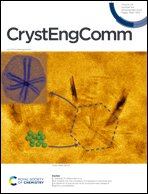Co-agglomerated crystals of cyclic nitramines with sterically crowded molecules†
Abstract
Co-crystallization of cyclic nitramines with sterically crowded molecules, i.e., ε-2,4,6,8,10,12-hexanitro-2,4,6,8,10,12-hexaazaisowurtzitane (ε-CL-20) with cis-1,3,4,6-tetranitrooctahydroimidazo-[4,5-d]imidazole (BCHMX), is very difficult, but the co-agglomeration (slurry method) of their mixed micro-co-particles gives very good results. CL-20 is present in these co-agglomerates (CACs) in its β-form. Besides the medium of co-agglomeration, also the molar ratio is very important; it is possible to obtain β-CL-20/BCHMX (molar 1.8/1.0) with the impact sensitivity of 14.9 J. The density of these CACs approaches 99.6% of the density of the β-CL-20 crystals. Based on the application of the Raman, FTIR and PXRD techniques, it has been proved that the agglomeration of CL-20/BCHMX micro-co-particles leads to the formation of CACs mostly with the properties of co-crystals (CCs). This also seems to be confirmed by the relationships between the heat of formation and ring-deformation vibrations (in plane) and between the impact sensitivity and the difference in the asymmetric NO2 stretching vibrations in pure CL-20 and its CACs. The CACs studied have lower detonation energies than would be consistent with the percentage of individual coformers in these crystals. An examination of the most sensitive CACs (1.2 J) as a detonator primer has shown the absence of its required acceleration capabilities in the given detonator design. A comparison with literature data and our unpublished preliminary results indicates that the CACs and CCs of this type could have potential beneficial applications in propellants.



 Please wait while we load your content...
Please wait while we load your content...